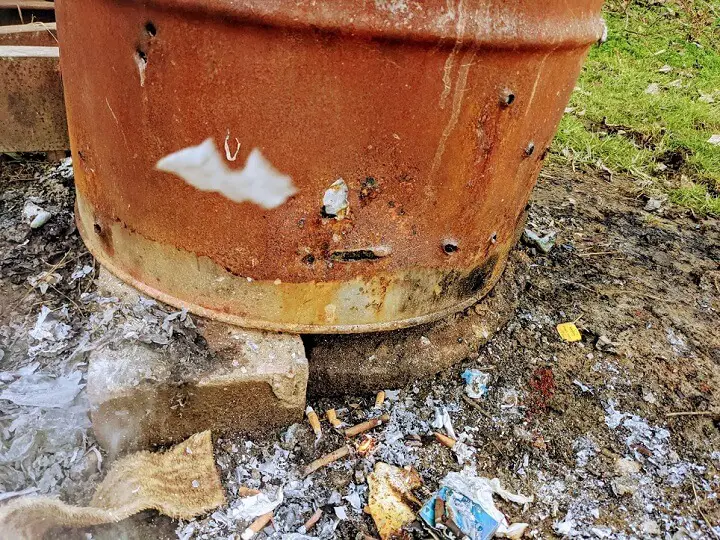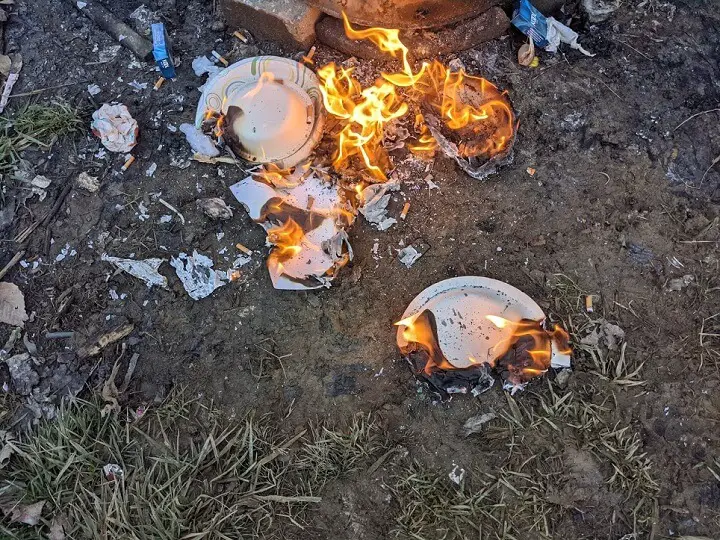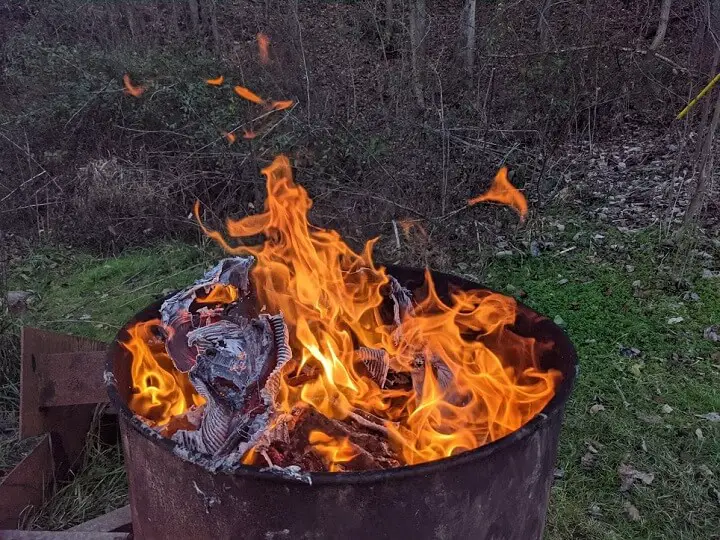[ad_1]

A burn barrel is typically crafted out of a 55-gallon drum. You can make a burn barrel out of a smaller metal drum, but it will not only hold less trash at a single time, it will also need to be dumped more often and could pose a greater risk of hot debris flowing outside of the safe containment area. Burn barrels are not dangerous to set up or use, as long as you do so properly—and follow state and local laws so you are not handed a steep fine.
Want to save this post for later? Click Here to Pin It On Pinterest!
The interior of a metal drum is fireproof and capable of withstanding high temperatures. Fires that burn hot create less smoke than low-temperature fires, which is another reason 55-gallon drums are favored when making a burn barrel.
The tall walls on this type of burn barrel make it more sturdy. Even when empty or barely full of ash, a 55-gallon drum burn barrel will be able to stand erect in even moderate winds.
Burn Barrel Location Is Crucial
One of the most important aspects of setting up a burn barrel involves choosing the right location. Just as in real estate, location is the key to success. Not only does the burn barrel have to be set in a level spot, it also must be on solid ground away from trees and structures.
Even the most careful actions when using a burn barrel cannot always prevent a stray spark or lightweight piece of burning debris from floating out of the barrel, up into the air, and landing somewhere it can catch something on fire.
Brush fires (or wildfires) spread quickly and are the most deadly of all types of blazes for firefighters to fight—and potentially the most destructive for any community. As the wife of a retired FD captain and a former local newspaper editor, I feel safe in firmly stating that I have witnessed and heard in great detail a lot about brush fires.
These types of fires take on a life of their own in rapid fashion. Brush fires eat everything in their path that is flammable, growing even larger, and can suddenly change direction when even a slight wind changes their path.
If you burn too much trash at a time or burn things that you shouldn’t, dangerous flames like these can grow large and spill out onto the ground.
Burn Barrel Basics
A 55-gallon drum is approximately 34 inches tall. This same drum is roughly 23 inches wide.
Holes must be cut into the barrel using a power drill or rounds fired through it using a firearm that uses ammo larger than .22 in caliber. The holes allow air to get into the barrel to help the flames “catch” and should be placed around the entire barrel, paying particular attention to the bottom portion of the sides.
You can also use a metal punch or a hammer and metal to make at least 10 to 15 ventilation holes in the 55-gallon drum. When setting up a new 55-gallon drum to use as a burn barrel, I typically shoot about 20 holes in it.
Put a few small holes in the bottom of the metal burn barrel for water drainage if you are not going to place a cover on the drum when it’s not in use. Ventilation holes must be put into the burn barrel, not only to allow rainwater to drain away but also to get more oxygen into the bottom of the barrel so the fire burns hotter and more efficiently.
The hotter the fire, the less smoke and scent it will create, which would be highly beneficial from an OPSEC perspective if burning trash and debris during a disaster.
Do not place a burn barrel directly onto the ground. Doing so will cause it to rot far more quickly once exposed to the elements. I advise using two cinder blocks sitting leveled and right next to each other or a concrete paver stone (or two) to place the burn barrel upon.
The metal will weaken and develop holes after it has been extensively used as a burn barrel and exposed to the elements. I can usually get about eight to 10 months out of a burn barrel before it needs to be replaced with a new 55-gallon drum.
Note the paver stones leveled beneath the burn barrel to elevate it off the ground to protect it from overexposure to the elements.
If using an old barrel instead of a recently purchased one, it is absolutely imperative to know exactly what the barrel housed before it was empty. It is not uncommon for flammable or combustible material to be manufactured and stored in 55-gallon drums. Using a barrel that contains any type of flammable or hazardous material could be a deadly mistake.
Place the burn barrel a minimum of 30 feet away from any other potentially flammable structure. It should also be at least 50 feet away from utility lines—even if they are underground.
Scrape or shovel an area at least four feet in diameter around the barrel until there’s nothing but dirt. This will help prevent sparks from the barrel catching anything on fire.
Burn Barrel Covers And Grates
Not everyone chooses to put a cover on their burn barrels, but doing so could add an extra level of safety. Since a tossed cigarette butt can start a wildfire that eventually wipes out hundreds of acres, doing your part to be responsible not only for your own land but for the homes around you is paramount.
If you stand at your burn barrel and have a fire extinguisher or a water hose within quick reach (being married to a firefighter is an added plus) you can still burn safely without using a burn barrel cover.
But, spending $10 on a small roll of hardware cloth (rabbit pen wire) and cutting it big enough to cover and fold around the top of your burn barrel is just a small chore that can prevent hot debris from escaping the 55-gallon drum (except for a few tiny pieces).
When using hardware cloth to make a cover for a burn barrel, drill or shoot some holes beneath the lip of the 55-gallon drum so you can bend a bit of wire through them or using thin wire from a spool to secure it in place when the burn barrel is in use.
A cover on a burn barrel would help prevent hot ash and small flaming pieces of debris from being blown out of the safe burning spot and potentially onto something that could spark a brush fire or house fire.
To protect the inside of the burn barrel from rusting prematurely when it rains or snows, place a lid of some type over it when not in use. A metal latching lid that often comes with purchased 55-gallon drums will work perfectly. If you do not have access to the original barrel lid, use a piece of scrap metal sheeting, rubber roofing, or heavy plastic to cover the opening.
A burn barrel cover could be secured in place by drilling holes around the edges and tying it to corresponding drilled openings in the lip of the 55-gallon drum with thin wire or by placing something with a little weight directly on top of the applied cover.
Some burn barrels are set up with a grate at the bottom or a galvanized metal tub (or both) to use as an ash catcher to reduce clean up chores and to increase the life of the 55-gallon drum. A grate and flanges set up inside the burn barrel can also help keep the matter being burned all collected in one spot, which will increase the heat of the fire and make it burn more quickly and with less smoke and scent.
What Not To Burn In A 55-Gallon Drum
Depending upon where you live, some of the items on the list below are not only a dangerous choice for tossing into the burn barrel, doing so may also be illegal.
- Hazardous Waste – Such as paint and containers that housed chemical cleaners.
- Plant Debris – The leavings from diseased trees and plants. This could release harmful spores into the air that could spread the plant disease.
- Food Scraps – Burning food does not work well and will attract bugs and rodents to the area around the burn barrel. Your food scraps would better be put to work in a compost pile on the homestead – or tossed to your hogs.
- Aerosol Cans
- Glass
- Lightbulbs
- Metal – common household metal and aluminum cans will NOT burn, they will just rust and become thin over time if left in the burn barrel.
- Styrofoam
- Damp Clothing – Fabric, or other otherwise safe to burn materials. The damp matter can kill the fire or cause it to burn slower, and a decreased temperature, and create a lot of smoke and scent in the process.
- Tires
- Empty Lighter Fluid Cans
- Empty Fuel Cans
How To Build A Burn Barrel
Materials:
- 55-gallon metal drum barrel
- 2 cinder blocks or paver stones
- Power drill with a 1 ½ bit – a gun, hammer, or metal punch
- Hardware cloth, grate, metal sheeting, rubber roofing, barrel lid – optional.
Instructions:
- Drill, hammer, punch, or safely shoot (if legal where you live) Add ventilation holes into the lower sides of the barrel by drilling, hammering, punching, or safely shooting (if legal where you live). Add as many as needed, but do not go overboard and create so many holes it decreases the stability of the barrel sides or bottom.
- Pick the location for the burn barrel using the guidance above.
- Clear the spot around the barrel down to dirt to reduce the threat of fire spreading if hot embers or burning debris falls out of the barrel.
- Place two cinder blocks in the desired barrel placement spot.
- Place the 55-gallon drum on top of the cinder blocks.
- Cut the grate and/or cover material to fit and use something heavy to secure it in place. Tin snips will quickly and easily cut through hardware cloth.
Burn Barrel Safety Tips
- Don’t overfill it. One or two standard kitchen-size bags of debris is enough. Overloading the barrel will vastly increase the risk of hot or flaming debris ending up on the ground or blowing elsewhere and potentially causing a fire.
- Putting too much debris in the burn barrel at any one time can also smother the fire by depriving it of air. A smoldering fire will stink and create a lot of smoke.
- Do not leave the fire unattended.
- Placing the barrel within reach of a garden hose or having a fire extinguisher nearby designed to extinguish the type of materials you are burning is highly advised.
- Make absolutely sure the fire is out before leaving the barrel unattended.
- Keep a thick and long wood stick or metal pole near the burn barrel to use to “stir” the fire to prevent smoldering, move heavy debris around, and generally tend to the blaze you’re building and containing in the 55-gallon drum.
- Ashes from the burn barrel can be excellent for the compost pile, but that will depend on the type of material being burnt. Never put ashes that come from burning plastic into a compost pile.
- Do not put trash into the burn barrel until you are ready to set it on fire. Any tiny bit of food left on a container will very quickly attract pests and wildlife to the barrel. A raccoon will rip into a sack of trash and spread it all over your homestead in a surprisingly short amount of time.
Burning trash is legal where I live, but that is not so in many other places—places that have pesky things called zoning laws, permit offices, and the like that do not exist in my rural patch of heaven.
Even in areas like mine where burning trash is legal, burning of any type can be restricted to specific hours or prohibited altogether during some hot and dry months. Never burn any item outdoors until carefully reviewing all state and local ordinances. Make sure you understand any rules related to the placement and type of container you want to use.
After reviewing local and state laws, carefully read your insurance policy to see if burning trash or other material on your property invalidates it. Even if you follow all the rules, laws, and ordinances and do everything right, a fire could still be started by your burning routine. If the burn barrel you are using causes a brush fire or the destruction of property in any way, you could be held legally liable for the damage.
Like this post? Don’t Forget to Pin It On Pinterest!
[ad_2]
Source link
Get more stuff like this
in your inbox
Don't Be Left Unprepared
Thank you for subscribing.
Something went wrong.







